combat
 The making of the weapons of warfare is not always an easy task, and sometimes there is a lot of trial and error. When the different countries decided to begin making tanks, there were as many different styles as countries involved. That might sound like a good thing, but making an effective battle tank is no small undertaking, even in the best of times. Building one under the pressure of war is next to impossible. In fact, given the complexity of the machines, high costs, and stress of combat, I don’t know how they managed to make them work at all. Of course, not all tank designs were failures. There were a number of successful tanks, of course. If there hadn’t been we wouldn’t have tanks today. They would have just given up. Nevertheless, there were also a lot of failures.
The making of the weapons of warfare is not always an easy task, and sometimes there is a lot of trial and error. When the different countries decided to begin making tanks, there were as many different styles as countries involved. That might sound like a good thing, but making an effective battle tank is no small undertaking, even in the best of times. Building one under the pressure of war is next to impossible. In fact, given the complexity of the machines, high costs, and stress of combat, I don’t know how they managed to make them work at all. Of course, not all tank designs were failures. There were a number of successful tanks, of course. If there hadn’t been we wouldn’t have tanks today. They would have just given up. Nevertheless, there were also a lot of failures.
Tanks like the Bob Semple Tank, so named for the New Zealand politician tasked with designing it. Sadly, this dud was built with what limited materials or expertise, Semple and his team could get their hands on. The tank was designed after a picture on an American postcard. Basically, it was a tractor wrapped in steel with six 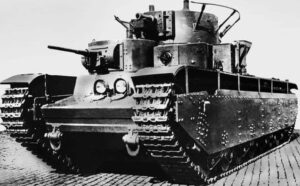 machine guns poking out at different angles. Ok, it might have looked like a tank, but that was about it. To change gear, it had to come to a complete stop…not a good way to ward off the enemy. One of the gunners of the eight-man crew had to lie on a mattress to squeeze into the cramped compartments, so he was pretty much done for it if the tank caught fire.
machine guns poking out at different angles. Ok, it might have looked like a tank, but that was about it. To change gear, it had to come to a complete stop…not a good way to ward off the enemy. One of the gunners of the eight-man crew had to lie on a mattress to squeeze into the cramped compartments, so he was pretty much done for it if the tank caught fire.
In true Hitler style, the Panzer VII Maus was the largest tank ever built. The size of the tank was its biggest downfall. The tank used too much fuel to be a logical option for a country running low on funds. In addition, the tank was so huge that it couldn’t maneuver through tree covered areas, and it was so slow that it couldn’t catch other tanks. It was also a sitting duck for aircraft looking to bomb it, because it just went so slowly.
The T-35, built in the Soviet Union, was the pride of the Red Army…until it was actually used in combat. This tank was outdated before it was built. A five-turret behemoth, it was a battleship on some seriously slow- moving treads. About the only thing it was good for was looking good in a parade. On the field…well, that was another matter. The T-35 required a 10-man crew to operate and many more to maintain. More than half of the 48 tanks used in the first attack in 1941, broke down before reaching the front.
moving treads. About the only thing it was good for was looking good in a parade. On the field…well, that was another matter. The T-35 required a 10-man crew to operate and many more to maintain. More than half of the 48 tanks used in the first attack in 1941, broke down before reaching the front.
Of course, there were other duds too. Probably too many to mention here. The tank was a good idea, and the good ones were like a rolling force field. The problem was that the ones that were poorly designed, rather outnumbered the ones that were good. I suppose that is why there are relatively few tank designs.
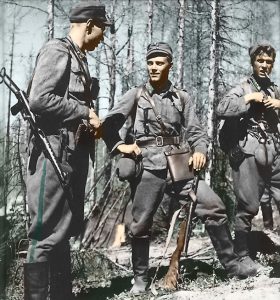 On June 26, 2003, a Green Beret was laid to rest at Arlington National Cemetery. That may not seem like such an unusual event, but in reality, it was very unusual. Lauri Allan Torni, aka Larry Thorne, was born in Viipuri, Finland on May 28, 1919. When he grew up, he entered the Finnish military service in 1938. He participated in the war between Finland and the USSR, proving himself in battle, and earning the rank of captain. It would appear that Torni would quite likely have a long and distinguished career in the military service.
On June 26, 2003, a Green Beret was laid to rest at Arlington National Cemetery. That may not seem like such an unusual event, but in reality, it was very unusual. Lauri Allan Torni, aka Larry Thorne, was born in Viipuri, Finland on May 28, 1919. When he grew up, he entered the Finnish military service in 1938. He participated in the war between Finland and the USSR, proving himself in battle, and earning the rank of captain. It would appear that Torni would quite likely have a long and distinguished career in the military service.
All that changed when Finland allied itself with Nazi Germany in 1941. In 1943, Torni put together a unit that was informally called Detachment Torni. This was an infantry unit that penetrated deep behind enemy lines, and they quickly made a reputation for themselves on both sides of the front for its combat effectiveness. For his part, Torni, for his Finnish military service was awarded 8 medals, to include the Mannerheim Cross, for action on July 9, 1944.
When his unit was demobilized, Torni joined a German SS unit in East Prussia and continued to fight the Russians, who at that time were the known enemy. During his time in the German SS, Torni was captured by the British, escaped a POW camp, and returned to Finland, where he was arrested for his German army service. I’m sure that at this point he wondered what was going on. I would think he realized the the German SS was his whole problem, but like many, he was fooled by Hitler and the Nazi party. After being pardoned in 1948, Torni secretly traveled to Sweden, masqueraded as a Swedish seaman, and sailed to the vicinity of Mobile, Alabama, 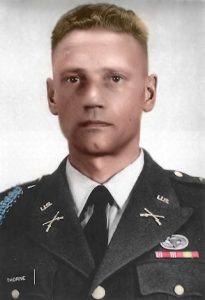 where he jumped overboard and made it to land. As most people know, getting to land was an opportunity to seek asylum, which Torni did. He was granted residency in 1953 and because he wanted to be loyal to his new country, Torni, now going by Larry Thorne joined the Army. Again, he proved himself in battle, and eventually became a Green Beret assigned to Special Forces. Torni, now Thorne was an incredible soldier, and very loyal to his nation and his fellow soldiers. He served in various high profile capacities around the world in his time of service as a Green Beret.
where he jumped overboard and made it to land. As most people know, getting to land was an opportunity to seek asylum, which Torni did. He was granted residency in 1953 and because he wanted to be loyal to his new country, Torni, now going by Larry Thorne joined the Army. Again, he proved himself in battle, and eventually became a Green Beret assigned to Special Forces. Torni, now Thorne was an incredible soldier, and very loyal to his nation and his fellow soldiers. He served in various high profile capacities around the world in his time of service as a Green Beret.
In 1963 when he was 44 years old, Thorne was deployed to Vietnam as an advisor, but two years later Torni’s remarkable career came to an end when his helicopter crashed during a secret mission. It was a tragic end to a short lived, be remarkable career. His remains were not located until 1999. Finally, on June 26, 2003, a multi-national hero and in the end, a celebrated Green Beret was laid to rest. He was an amazing soldier.
 So many of the men and women who return from combat, when many of their buddies didn’t, suffer from a multitude of feelings. Many feel like it should been them killed in the bombing, shooting, plane crash, or whatever it might have been that took their buddy or buddies, and somehow let them alive. No matter that they were quite possibly wounded too, maybe even lost a limb. The point was that somehow they had come back alive, and they carry the guilt of that with them always.
So many of the men and women who return from combat, when many of their buddies didn’t, suffer from a multitude of feelings. Many feel like it should been them killed in the bombing, shooting, plane crash, or whatever it might have been that took their buddy or buddies, and somehow let them alive. No matter that they were quite possibly wounded too, maybe even lost a limb. The point was that somehow they had come back alive, and they carry the guilt of that with them always.
Some of those returning heroes struggle with the loss of their feeling all their lives. Some of them take risks, feeling like they are living on borrowed time, and if their time comes, it will almost be a form of justice. Some feel 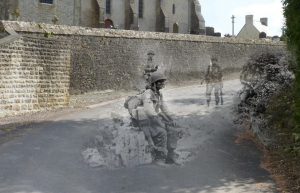 like it is borrowed time, but look at it more like living a gift. They might try to live up to what they think would make their buddies would be proud of. It doesn’t matter how they live their lives, for some, it will never be enough…in their minds anyway. They feel like their buddy died, and because of that, they can have a family…one their buddy never got to have. And if those buddies who were lost had a family, they feel an even greater burden, because not only did their buddy lose out of being with his family, but the family lost him too.
like it is borrowed time, but look at it more like living a gift. They might try to live up to what they think would make their buddies would be proud of. It doesn’t matter how they live their lives, for some, it will never be enough…in their minds anyway. They feel like their buddy died, and because of that, they can have a family…one their buddy never got to have. And if those buddies who were lost had a family, they feel an even greater burden, because not only did their buddy lose out of being with his family, but the family lost him too.
War is not an easy thing to go through, and those of us who are home, especially those of us with no one in the war, cannot really understand what  they go through either in the war, or after the war. It’s impossible. There are other kinds of survivors guilt, and I don’t suppose one is easier than the other, but it seems to me that because of the trust, companionship, and love these men feel for each other; and the idea that in the end, he couldn’t save the buddy or buddies who he felt were somehow his responsibility…well, it would be devastating. I can’t even begin to imagine. And the mind is a tough thing to get past, once it gets an idea firmly ingrained in it. For many soldiers, finally deciding that they aren’t living on borrowed time is a lifelong process, and all their family can do is pray they can make the transition back to living life again. I pray they can too.
they go through either in the war, or after the war. It’s impossible. There are other kinds of survivors guilt, and I don’t suppose one is easier than the other, but it seems to me that because of the trust, companionship, and love these men feel for each other; and the idea that in the end, he couldn’t save the buddy or buddies who he felt were somehow his responsibility…well, it would be devastating. I can’t even begin to imagine. And the mind is a tough thing to get past, once it gets an idea firmly ingrained in it. For many soldiers, finally deciding that they aren’t living on borrowed time is a lifelong process, and all their family can do is pray they can make the transition back to living life again. I pray they can too.
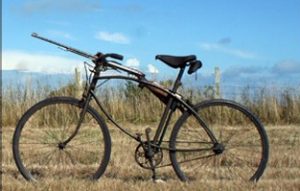
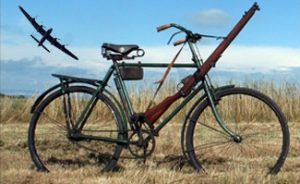 When we think about war machines, we think of planes, tanks, ships, and even horses, but we very seldom…if ever, think of bicycles. Nevertheless, bicycles were used in a number of wars, and even continue to be used to this day. The late 19th century brought several experiments into the possible role of bicycles and cycling within military establishments, primarily because they can carry more equipment and travel longer distances than walking soldiers could. The development of pneumatic tires coupled with shorter, sturdier frames in the late 19th century led military establishments to investigate the possibility of bicycles in combat. To some extent, bicyclists took over the functions of dragoons, especially as messengers and scouts, substituting for horses in warfare. Bicycle units or detachments were in existence by the end of the 19th century in most armies.
When we think about war machines, we think of planes, tanks, ships, and even horses, but we very seldom…if ever, think of bicycles. Nevertheless, bicycles were used in a number of wars, and even continue to be used to this day. The late 19th century brought several experiments into the possible role of bicycles and cycling within military establishments, primarily because they can carry more equipment and travel longer distances than walking soldiers could. The development of pneumatic tires coupled with shorter, sturdier frames in the late 19th century led military establishments to investigate the possibility of bicycles in combat. To some extent, bicyclists took over the functions of dragoons, especially as messengers and scouts, substituting for horses in warfare. Bicycle units or detachments were in existence by the end of the 19th century in most armies.
By World War I, the level terrain in Belgian was well used by military cyclists, prior to the onset of trench 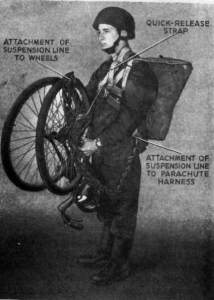 warfare. Each of the four Belgian carabinier battalions included a company of cyclists, equipped with a brand of folding, portable bicycle named the Belgica. A regimental cyclist school gave training in map reading, reconnaissance, reporting, and the carrying of verbal messages. Attention was paid to the maintenance and repair of the machine itself. The bicycle could be used to ride when it was feasible, and carried when the pat was not suitable to riding. The bicycle made no noise, so unless the trail was littered with twigs, the bicycle make very little noise. Sneaking up on the enemy was possible.
warfare. Each of the four Belgian carabinier battalions included a company of cyclists, equipped with a brand of folding, portable bicycle named the Belgica. A regimental cyclist school gave training in map reading, reconnaissance, reporting, and the carrying of verbal messages. Attention was paid to the maintenance and repair of the machine itself. The bicycle could be used to ride when it was feasible, and carried when the pat was not suitable to riding. The bicycle made no noise, so unless the trail was littered with twigs, the bicycle make very little noise. Sneaking up on the enemy was possible.
In the United States, the most extensive experimentation on bicycle units was carried out by 1st Lieutenant Moss, of the 25th United States Infantry (Colored), which was made up of African American infantry soldiers with European American officers. Using a variety of cycle models, Moss and his troops carried out extensive bicycle journeys covering between 800 and 1,900 miles. Late in the 19th century, the United States Army tested the bicycle’s suitability for cross-country troop transport. Buffalo Soldiers stationed in Montana rode bicycles across roadless landscapes for hundreds of miles at high speed. The “wheelmen” traveled the 1,900 Miles to Saint Louis, Missouri in 34 days with an average speed of over 6 miles per hour. The bicycles were even used in the paratrooper deployment. These bicycles not only folded up, but they were equipped with an on board rifle. I don’t know how hard it was to handle a gun while riding a bike, but I’m sure it was a relief to have your gun right there.
The first known use of the bicycle in combat occurred during the Jameson Raid, in which cyclists carried messages. In the Second Boer War, military cyclists were used primarily as scouts and messengers. One unit  patrolled railroad lines on specially constructed tandem bicycles that were fixed to the rails. Several raids were conducted by cycle-mounted infantry on both sides; the most famous unit was the Theron se Verkenningskorps (Theron Reconnaissance Corps) or TVK, a Boer unit led by the scout Daniel Theron, whom British commander Lord Roberts described as “the hardest thorn in the flesh of the British advance.” Roberts placed a reward of £1,000 on Theron’s head…dead or alive…and dispatched 4,000 soldiers to find and eliminate the TVK. While scouting alone on a road near Gatsrand, about 3.7 miles north of present-day Fochville, he encountered seven members of Marshall’s Horse and was killed in action.
patrolled railroad lines on specially constructed tandem bicycles that were fixed to the rails. Several raids were conducted by cycle-mounted infantry on both sides; the most famous unit was the Theron se Verkenningskorps (Theron Reconnaissance Corps) or TVK, a Boer unit led by the scout Daniel Theron, whom British commander Lord Roberts described as “the hardest thorn in the flesh of the British advance.” Roberts placed a reward of £1,000 on Theron’s head…dead or alive…and dispatched 4,000 soldiers to find and eliminate the TVK. While scouting alone on a road near Gatsrand, about 3.7 miles north of present-day Fochville, he encountered seven members of Marshall’s Horse and was killed in action.
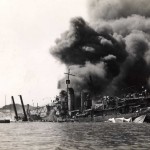 Seventy one years ago today, one of the most horrific attacks ever launched on US soil took place. Following that attack, the United States entered World War II. That would eventually lead to the men who would become my dad and my uncles, also entering World War II. So many people think that the United States loves to go to war, but that is simply not the case. The United States is a nation of people who try to give everyone the right to live and let live, but if we are provoked or if another nation is in need, most nations or terrorists will find that we are a nation they will wish they had not messed with.
Seventy one years ago today, one of the most horrific attacks ever launched on US soil took place. Following that attack, the United States entered World War II. That would eventually lead to the men who would become my dad and my uncles, also entering World War II. So many people think that the United States loves to go to war, but that is simply not the case. The United States is a nation of people who try to give everyone the right to live and let live, but if we are provoked or if another nation is in need, most nations or terrorists will find that we are a nation they will wish they had not messed with.
Our family has not lost a soldier to war that I am aware of, at least not as far back and including World War I, so I don’t know what it feels like to lose someone to combat. I do know that whenever our nation is involved in a war, my prayers go out for protection for all our soldiers…those I know and those I don’t.
There have been times when our nation has been divided over whether or not we should be involved in a war, but when it is an attack on our soil, very few people protest the war. It just feels different, more personal, whether we know anyone who lost their life or not. They are our people, and this is our nation…our safe zone, and we don’t like having anyone come in and violate that safe zone. The attack on Pearl Harbor came as such a shock to so many people, because they had been lead to believe that we had made an 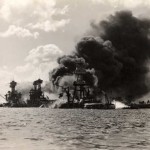 agreement with Japan that they would honor, but no matter what they are like today, they did not honor the agreement made than, and many people paid for our nation’s trusting ways with their lives.
agreement with Japan that they would honor, but no matter what they are like today, they did not honor the agreement made than, and many people paid for our nation’s trusting ways with their lives.
The attack on Pearl Harbor will forever be embedded in the minds of those who lived it and those who have studied it. Today, I want to honor all the men and women who lost their lives at Pearl Harbor and in World War II, and all the men and women who have served their country in World War II and all the other wars our nation has been involved in. Thank you all for your service.

